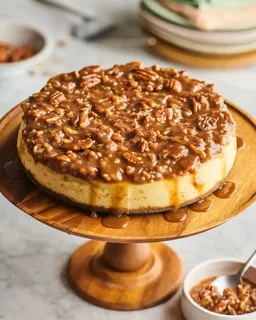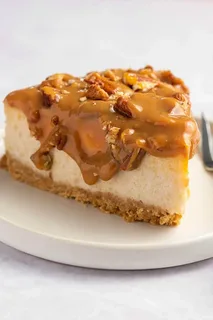Indulge in the world of Caramel Pecan Cheesecake, a decadent dessert that combines the nutty crunch of pecans with the silky smoothness of caramel and cheesecake. This delightful confectionery creation is more than just a treat; it’s a journey through a rich culinary landscape.
The roots of Caramel Pecan Cheesecake trace back to the classic cheesecake, believed to have originated in ancient Greece. It evolved over centuries, traveling through Europe and eventually reaching America, where it was embraced and reinvented in numerous ways. The addition of caramel and pecans is a relatively recent innovation, reflecting the ever-evolving nature of this beloved dessert.
What is Caramel Pecan Cheesecake?
A Culinary Masterpiece
Caramel Pecan Cheesecake is a luxurious dessert that artfully combines several elements:
- Creamy Cheesecake Base: The foundation is a rich, creamy cheesecake, often made with a blend of cream cheese, sugar, eggs, and vanilla.
- Crunchy Pecan Element: Embedded within or sprinkled atop, pecans add a delightful crunch and nutty flavor.
- Caramel Infusion: Drizzled over or swirled within, caramel brings a sweet, buttery component that perfectly complements the cheesecake and pecans.
Its Place in Culinary History
This dessert stands as a testament to culinary innovation and fusion:
- Evolution of Cheesecake: From its simple beginnings, cheesecake has evolved into a canvas for creativity, adopting flavors and toppings that reflect local tastes and ingredients.
- American Twist: The introduction of caramel and pecans is quintessentially American, showcasing the love for rich, indulgent flavors in the U.S. culinary scene.
Caramel Pecan Cheesecake is not just a dessert; it’s a symbol of how traditional recipes can be transformed into new, exciting creations. It represents a blend of history and modern taste, a dish that continues to evolve and delight palates worldwide.
Key Ingredients
The magic of Caramel Pecan Cheesecake lies in its ingredients. Each plays a pivotal role in creating this mouth-watering dessert.
Main Ingredients and Their Roles
- Cream Cheese:
- Foundation: The base of the cheesecake, providing a rich, creamy texture.
- Tip: Use full-fat cream cheese for the best flavor and texture.
- Sugar:
- Sweetness: Balances the tanginess of the cream cheese.
- Variation: Both white and brown sugar can be used, with brown sugar adding a deeper flavor.
- Eggs:
- Binding Agent: Eggs help to bind the mixture and give the cheesecake its structure.
- Tip: Room temperature eggs blend more smoothly into the batter.
- Vanilla Extract:
- Flavor Enhancer: Adds depth and aroma to the cheesecake.
- Pecans:
- Crunch and Nuttiness: Offers a contrasting texture and rich, nutty flavor.
- Tip: Toasting the pecans before use enhances their flavor.
- Caramel Sauce:
- Sweet Topping: Drizzled on top for a luscious, gooey finish.
- Option: Use homemade or store-bought caramel sauce.
- Graham Cracker Crust:
- Base: Provides a crunchy, sweet foundation for the cheesecake.
- Variation: Substitute with ginger snaps or chocolate biscuits for a different flavor profile.
Step-by-Step Recipe for Classic Cheesecake
Ingredients and Preparations
Before diving into the baking process, gather all your ingredients and necessary equipment. For a classic cheesecake, you’ll need:
- Cream cheese
- Sugar
- Eggs
- Vanilla extract
- A crust (typically made from graham crackers or digestive biscuits)
- A springform pan
Detailed Recipe Instructions
- Crust Preparation: Begin by preparing your crust. Crush graham crackers or biscuits into fine crumbs and mix with melted butter. Press this mixture firmly into the bottom of your springform pan and bake for a few minutes until set.
- Cheesecake Filling: For the filling, beat cream cheese until smooth, then gradually add sugar. Incorporate eggs one at a time, followed by vanilla extract. Pour this mixture over your prepared crust.
- Baking: Bake your cheesecake in a preheated oven. The key is to avoid overbaking, as cheesecakes continue to cook once removed from the oven.
- Cooling and Setting: Allow the cheesecake to cool gradually in the oven with the door slightly open. Then, refrigerate for several hours to set completely.
Tips for Achieving the Perfect Cheesecake
- Avoid Cracks: To prevent cracks, avoid overmixing the batter and don’t open the oven door frequently while baking.
- Water Bath: Consider using a water bath to ensure even cooking and a creamy texture.
- Temperature: Ingredients should be at room temperature to blend smoothly.
- Resting: Let the cheesecake rest in the fridge overnight for the best flavor and texture.
Variations and Customizations
Exploring Different Styles and Flavors
- New York Style: Rich and dense, featuring extra cream cheese and eggs.
- French Style: Lighter, with the addition of sour cream or heavy cream.
- Japanese Style: Known for its airy, fluffy texture, achieved by incorporating whipped egg whites.
Creative Customization Ideas
- Fruit Toppings: Add a layer of your favorite fruit compote or fresh fruits.
- Chocolate Swirl: Create a marble effect with melted chocolate swirled into the batter.
- Citrus Zest: Incorporate lemon, lime, or orange zest for a refreshing twist.
- Spice Infusion: Experiment with spices like cinnamon or nutmeg for a warm flavor.
Health and Nutritional Aspects
Cheesecake, while indulgent, can also incorporate ingredients that offer certain health benefits. Understanding these can help in making more informed dietary choices.
Health Benefits of Main Ingredients
- Cream Cheese: A good source of vitamin A and contributes to your daily intake of calcium.
- Eggs: Provide high-quality protein and contain essential vitamins and minerals.
- Graham Crackers/Digestive Biscuits: Offer a modest amount of fiber, especially if whole grain options are used.
Dietary Considerations
- Gluten-Free Options: For a gluten-free cheesecake, opt for a crust made from gluten-free biscuits or a blend of nuts and dates.
- Vegan Alternatives: Vegan cream cheese and egg substitutes like silken tofu or agar-agar can be used to create a dairy-free and egg-free cheesecake.
Storage and Preservation
Proper storage is crucial for maintaining the quality and extending the shelf life of cheesecake.
Best Practices for Storing
- Refrigeration: Cheesecake should always be stored in the refrigerator, tightly covered to prevent it from absorbing other food odors.
- Freezing: For longer storage, cheesecake can be frozen. Wrap it tightly in plastic wrap and then aluminum foil. Thaw in the refrigerator before serving.
Shelf Life Details
- Refrigerator: A properly stored cheesecake can last up to 7 days in the refrigerator.
- Freezer: When frozen, it can maintain its quality for about 1-2 months.
By considering these health and nutritional aspects and following the best storage practices, you can enjoy cheesecake in a way that fits your lifestyle and dietary preferences, while also ensuring it remains fresh and delicious.
Pairing and Serving Suggestions
Enhancing Your Cheesecake Presentation
First impressions matter, especially in the culinary world. Here’s how you can make your cheesecake not only taste but also look irresistible:
Ideas for Serving and Presentation
- Artful Garnishing: Enhance your cheesecake with eye-catching garnishes. Consider fresh berries, mint leaves, or a sprinkle of powdered sugar for a touch of elegance.
- Sauce Creativity: Elevate the flavor with a drizzle of caramel, chocolate, or berry sauce. This not only adds a burst of flavor but also makes for a striking visual contrast.
- Layer of Luxury: A dollop of whipped cream on top of each slice adds a creamy, luxurious texture.
Complementing with Foods and Drinks
The right pairings can significantly enhance the cheesecake experience:
- Beverage Pairings: A hot cup of coffee or tea makes a great companion to cheesecake, balancing its richness. For a more sophisticated touch, pair it with a sweet dessert wine like Riesling or Moscato.
- Fruit Companions: A side of fresh fruit salad can offer a refreshing counterpoint to the dense, creamy texture of the cheesecake.
Troubleshooting Common Issues
Even experienced bakers can face challenges when making cheesecake. Here’s how to address some of the most common issues:
Solving Frequent Baking Problems
Cheesecake can be a bit finicky, but these tips can help you navigate common obstacles:
- Preventing Cracks: Avoid overmixing the batter and consider using a water bath to ensure even cooking and minimize surface cracking.
- Ensuring Even Cooking: Halfway through the baking process, rotate the cheesecake to promote uniform cooking.
- Avoiding a Soggy Crust: Pre-bake your crust and let it cool before adding the filling to prevent it from becoming soggy.
Achieving Cheesecake Perfection
A few key practices can make all the difference in achieving the perfect cheesecake:
- Room Temperature Ingredients: Using ingredients at room temperature helps them blend more smoothly, avoiding lumps in the batter.
- Gradual Cooling: Let the cheesecake cool slowly in the oven with the door slightly open. This gradual process helps prevent the top from cracking.
- Patience is Key: Allow the cheesecake to set completely in the refrigerator before slicing. This waiting period is crucial for the cheesecake to achieve the right consistency.
Common Cheesecake Queries
No-Bake Cheesecake Issues
Why is my no-bake cheesecake not firm?
A common issue with no-bake cheesecakes is achieving the right firmness. If your cheesecake isn’t setting properly, consider these factors:
- Ingredient Ratios: Ensure you’re using the correct proportions of cream cheese, sugar, and setting agents like gelatin.
- Chilling Time: No-bake cheesecakes generally need several hours, preferably overnight, in the refrigerator to set properly.
- Quality of Ingredients: Using full-fat cream cheese can impact the firmness and texture.
Toasting Nuts for Cheesecakes
What is the best way to toast pecans for a cheesecake?
Toasting pecans not only enhances their flavor but also adds a delightful crunch to your cheesecake. Here’s how to do it:
- Oven Toasting: Spread pecans in a single layer on a baking sheet and toast in a preheated oven at 350°F (175°C) for about 7-10 minutes. Keep an eye on them to prevent burning.
- Skillet Toasting: For a quicker method, toast pecans in a dry skillet over medium heat, stirring frequently until they’re aromatic and slightly browned.
Additional Frequently Asked Questions
Perfect Cheesecake Texture
- How do I achieve a creamy cheesecake texture?
Use room temperature ingredients and mix gently to avoid incorporating too much air into the batter.
Avoiding Cracks
- How can I prevent cracks in my cheesecake?
Avoid overmixing, bake in a water bath, and let it cool gradually in the oven with the door ajar.
Cheesecake Flavor Enhancements
- How can I enhance the flavor of my cheesecake?
Experiment with different extracts, zests, or stir in a bit of sour cream for a tangy flavor.
Dietary Adaptations
- Are there dairy-free cheesecake options?
Yes, you can use dairy-free cream cheese and plant-based milk alternatives.
Shelf Life
- How long does cheesecake last in the fridge?
Properly stored, cheesecake can last up to 7 days in the refrigerator.


